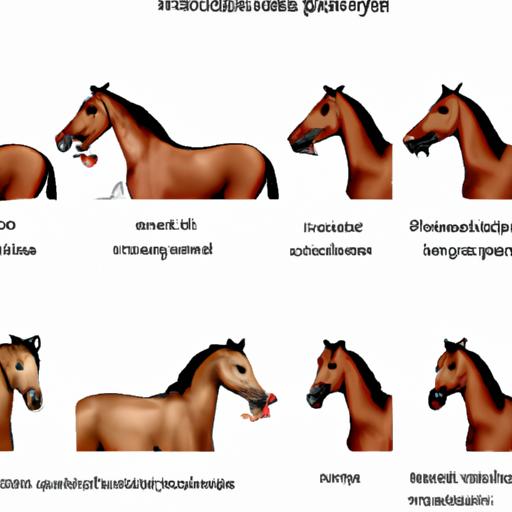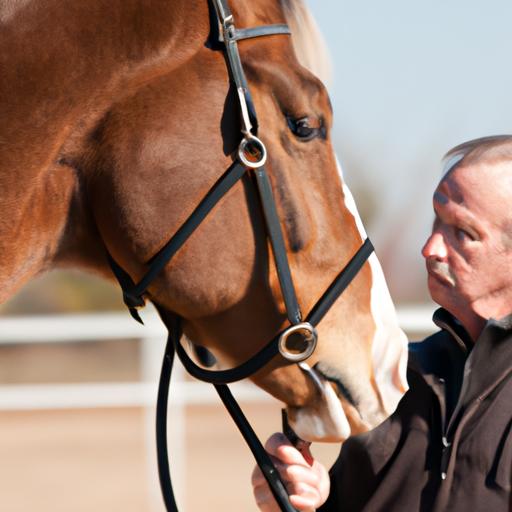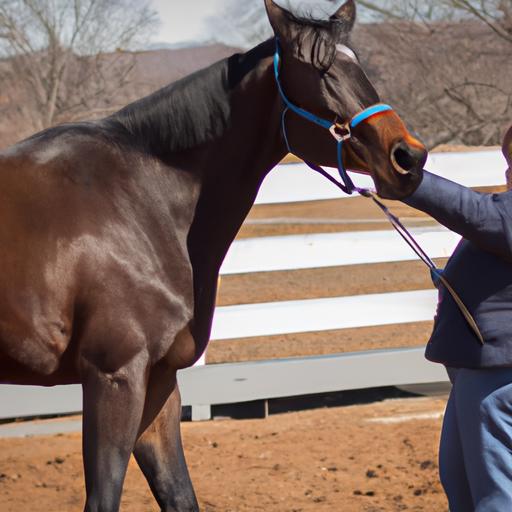Unlock the secrets of horse mouthing behavior and learn how to understand, manage, and address this intriguing equine trait. Dive into our comprehensive guide now!
Introduction
Horses, magnificent creatures that they are, possess a range of behaviors that can sometimes leave us puzzled. One such behavior that horse owners and enthusiasts often encounter is horse mouthing behavior. In this article, we will delve into the depths of this intriguing behavior, exploring its definition, significance, and how it can be better understood and managed. So, saddle up and let’s embark on this enlightening journey together.
What is horse mouthing behavior?
Horse mouthing behavior refers to the act of horses gently grasping objects with their lips and teeth, often accompanied by a rhythmic movement. It is a natural behavior that serves various purposes in their social interactions and daily routines. Whether it’s nibbling on a fence, playfully tugging on a lead rope, or even mouthing other horses, this behavior is a part of their communication repertoire.
Importance of understanding horse mouthing behavior
Understanding horse mouthing behavior is crucial for several reasons. Firstly, it allows us to differentiate between normal equine behavior and potential underlying issues that may require attention. By being attuned to this behavior, we can determine whether it stems from boredom, stress, discomfort, or even a dental problem, ensuring the horse’s well-being and overall health.
Furthermore, comprehending horse mouthing behavior enables us to establish a stronger bond with our equine companions. By decoding their nonverbal communication, we can better respond to their needs and create a sense of trust and understanding. This, in turn, paves the way for effective training and enhances the overall partnership between horse and rider.
Overview of the article’s objectives
Throughout this article, we will explore the signs and signals of horse mouthing behavior, its impact on both the horse and the rider, and how to effectively manage and address this behavior. By the end, you will have a deeper understanding of this fascinating equine trait, equipping you with the knowledge to navigate it with confidence.
So, let’s delve into the world of horse mouthing behavior and unlock the secrets behind this captivating behavior. Ready to uncover the mysteries of the equine realm? Let’s embark on this adventure together.
Next section: Understanding Horse Mouthing Behavior
Understanding Horse Mouthing Behavior

Definition and Explanation of Horse Mouthing Behavior
To truly understand horse mouthing behavior, we must delve into its definition and explore its underlying mechanics. Horse mouthing behavior involves the gentle grasping of objects using the lips and teeth, accompanied by a rhythmic movement. This behavior is a natural instinct deeply rooted in equine communication and social interactions.
Horses use their mouths to explore the world around them, much like humans use their hands. By grasping objects, they gather sensory information, assess their surroundings, and establish connections with their environment. It is essential to recognize that mouthing behavior is not inherently negative or problematic; rather, it is a fundamental aspect of equine behavior.
Possible Reasons Why Horses Display Mouthing Behavior
Now, you may be wondering why horses display mouthing behavior in the first place. Several factors can contribute to this behavior, and understanding them is key to addressing it effectively. Here are some common reasons why horses engage in mouthing behavior:
-
Exploration and Curiosity: Horses are naturally curious creatures, constantly seeking to understand their surroundings. Mouthing behavior allows them to investigate objects, textures, and scents, satisfying their innate curiosity.
-
Boredom and Stimulation: Horses may resort to mouthing behavior when they feel bored or lack mental stimulation. It can serve as a way to alleviate boredom and engage their minds, particularly in situations where they have limited access to forage or social interaction.
-
Stress and Anxiety: Like humans, horses may exhibit certain behaviors as a response to stress or anxiety. Mouthing behavior can serve as a self-soothing mechanism, providing a sense of comfort and familiarity in challenging situations.
Common Situations Where Horse Mouthing Behavior Occurs
Horse mouthing behavior can manifest in various situations, and being aware of these scenarios can help us better understand its triggers. Here are some common situations where horse mouthing behavior often occurs:
-
Interaction with Objects: Horses may engage in mouthing behavior when presented with novel objects, such as toys, buckets, or even fences. This behavior allows them to establish a tactile connection with the object and gather information about it.
-
Social Interaction: Mouthing behavior is also prevalent during social interactions with other horses. It can serve as a form of bonding, communication, and playfulness within the herd dynamics.
-
Handling and Training: Horses may exhibit mouthing behavior while being handled or during training sessions. This behavior can be a response to stress, anticipation, or even an attempt to seek attention from their human counterparts.
By understanding the definition, reasons, and common situations associated with horse mouthing behavior, we lay the foundation for effectively managing and addressing this behavior. In the next section, we will explore the signs and signals that horses display during mouthing behavior, allowing us to better recognize and interpret their communication cues.
Next section: Signs and Signals of Horse Mouthing Behavior
Signs and Signals of Horse Mouthing Behavior

Physical signs exhibited by horses during mouthing behavior
When a horse engages in mouthing behavior, there are several physical signs that can help us identify and understand their intentions. These signs include:
-
Lip movements: Horses may exhibit rhythmic movements of their lips while mouthing. This can involve gentle grasping motions or a slight chewing motion.
-
Teeth contact: During mouthing, horses may make contact between their teeth and the object or surface they are mouthing. This can range from a gentle nip to a more forceful bite, depending on the horse’s intentions.
-
Object exploration: Horses may use their mouths to explore objects or surfaces, especially when they encounter something new or unfamiliar. This can involve gentle nibbling or mouthing to gather information about the object’s texture, taste, or scent.
Behavioral cues indicating horse mouthing behavior
Apart from the physical signs, there are also behavioral cues that can indicate when a horse is engaging in mouthing behavior. These cues include:
-
Head and neck movements: Horses may tilt their heads or stretch their necks out towards the object they are mouthing. This can indicate their interest and focus on the specific item.
-
Relaxed body language: When horses engage in mouthing behavior, they often exhibit a relaxed and calm demeanor. Their ears may be forward or slightly to the side, and their overall body posture tends to be loose and at ease.
-
Repetition and persistence: Horses may repeatedly mouth the same object or engage in persistent mouthing behavior, especially if they find the object interesting or enjoyable. This can indicate their desire for interaction or stimulation.
Recognizing the difference between normal horse behavior and mouthing behavior
It is essential to differentiate between normal horse behavior and mouthing behavior to better understand the horse’s intentions and needs. While mouthing is a natural behavior, there are instances where it may require attention or intervention. Some factors to consider when distinguishing between the two include:
-
Context: Assess the context in which the behavior occurs. Is the horse mouthing during play or social interactions, or is it displaying mouthing behavior excessively or in inappropriate situations?
-
Intensity: Consider the intensity of the mouthing behavior. Is the horse gently mouthing an object, or is it displaying aggressive or destructive mouthing?
-
Duration: Evaluate the duration of the mouthing behavior. Is it a brief and occasional behavior, or does it persist for extended periods, potentially indicating a behavioral or health issue?
By being aware of these signs, cues, and distinctions, you can better understand your horse’s mouthing behavior and respond appropriately to their needs.
Next section: Impact of Horse Mouthing Behavior on Horse and Rider
Impact of Horse Mouthing Behavior on Horse and Rider

A. Effects of mouthing behavior on the horse’s well-being and health
When it comes to horse mouthing behavior, it’s essential to consider its impact on the horse’s overall well-being and health. While mouthing is a natural behavior, excessive or inappropriate mouthing can lead to various issues. Constantly grasping objects or nibbling on fences can result in dental problems, such as worn-down teeth or even broken fragments. This can cause discomfort and pain for the horse, affecting their ability to eat and perform tasks effectively.
Moreover, excessive mouthing can also be a sign of anxiety, stress, or boredom in horses. If left unaddressed, these underlying issues can lead to a decline in the horse’s overall mental and emotional well-being. It is crucial for horse owners and handlers to monitor their equine companions closely and identify any patterns of excessive mouthing that may require intervention.
B. Safety concerns for riders and handlers when dealing with a horse exhibiting mouthing behavior
Horses exhibiting mouthing behavior also pose potential safety concerns for riders and handlers. The gentle grasping and tugging associated with mouthing can escalate into more forceful behavior, potentially leading to accidental bites or injuries. This is particularly important to note when handling young or inexperienced horses, as their mouthing behavior may not be as controlled or predictable.
Furthermore, if a horse becomes fixated on mouthing during riding or training sessions, it can distract them from focusing on the rider’s cues or commands. This lack of attention can compromise the safety of both horse and rider, increasing the risk of accidents or miscommunication. It is crucial for riders and trainers to address and redirect excessive mouthing behavior to ensure a safe and harmonious partnership.
C. Potential implications for horse training and riding performance
Mouthing behavior can have implications for horse training and riding performance. Excessive mouthing can hinder the development of a soft and responsive mouth, making it challenging for riders to establish clear communication through rein aids. This can affect the horse’s ability to perform precise maneuvers or respond to subtle cues, impacting their overall performance in various disciplines.
Addressing mouthing behavior through appropriate training techniques can help horses develop better mouthing habits and improve their responsiveness to rein aids. By redirecting the mouthing behavior towards appropriate objects or activities, riders can encourage the horse to focus on the task at hand and enhance their overall training progression.
In the next section, we will explore effective strategies for managing and addressing horse mouthing behavior, providing you with practical tools to navigate this behavior and promote a harmonious partnership with your equine companion.
Next section: Managing and Addressing Horse Mouthing Behavior
Managing and Addressing Horse Mouthing Behavior
Preventive measures to minimize mouthing behavior in horses
To minimize horse mouthing behavior, it is essential to implement preventive measures that address the underlying causes. Here are some strategies you can employ:
-
Provide Ample Mental Stimulation: Boredom can often lead to mouthing behavior. Ensure your horse has access to a stimulating environment with plenty of turnout time, social interaction with other horses, and engaging activities such as toys or treat-dispensing puzzles.
-
Maintain a Healthy Diet: A well-balanced diet can play a significant role in reducing mouthing behavior. Ensure your horse receives appropriate nutrition, including adequate roughage and forage. Consult with a veterinarian or equine nutritionist to ensure your horse’s dietary needs are met.
-
Regular Dental Care: Dental issues can contribute to mouthing behavior. Schedule routine dental check-ups and floating to ensure your horse’s teeth are in good condition. This will not only improve their overall comfort but also minimize the urge to mouth objects.
Training techniques to modify or redirect mouthing behavior
When it comes to modifying or redirecting mouthing behavior, consistent training methods can be highly effective. Consider the following techniques:
-
Positive Reinforcement: Utilize positive reinforcement training methods to reward desired behaviors and discourage mouthing. When your horse displays appropriate behavior, such as refraining from mouthing or redirecting their attention elsewhere, reward them with praise, treats, or a gentle pat.
-
Teach “Leave It” Command: Teach your horse the “leave it” command to redirect their focus away from mouthing objects. Start by using treats or toys and gradually apply the command in different situations. Consistency and repetition are key to reinforcing this behavior.
-
Engage in Desensitization: Gradual desensitization can help your horse become accustomed to the presence of objects they tend to mouth. Introduce these objects in a controlled manner, allowing your horse to explore and interact with them without displaying excessive mouthing behavior. Over time, this can help reduce their inclination to mouth certain items.
Professional help and resources for addressing severe or persistent mouthing behavior
If you are facing challenges in managing severe or persistent mouthing behavior, seeking professional help can provide valuable guidance and support. Consider the following resources:
-
Consulting an Equine Behaviorist: An equine behaviorist or trainer experienced in addressing equine behaviors can assess your horse’s specific situation and provide customized strategies to manage and modify mouthing behavior effectively.
-
Joining Online Communities: Engage with online equine communities or forums where experienced horse owners and trainers share their insights and experiences. You can gain valuable advice, recommendations, and support from fellow horse enthusiasts who have dealt with similar issues.
Remember, addressing horse mouthing behavior requires patience, consistency, and a tailored approach. By implementing preventive measures, employing training techniques, and seeking professional assistance when needed, you can successfully manage and modify this behavior, fostering a harmonious partnership with your equine companion.
Next section: Conclusion


